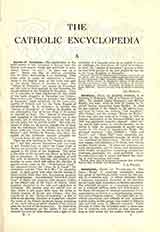

Assizes of Jerusalem.—The signification of the word assizes in this connection is derived from the French verb asseoir, whose past participle is assis. Asseoir means “to seat”, “to place one on a seat”. Hence the idea of putting something into its place, determining it to something. Thus assise came to mean an enactment, a statute. Assize is the English form of the word, and used in the plural, assizes, it denotes a court. The “Assizes of Jerusalem” (les assizes de Jerusalem) are the code of laws enacted by the Crusaders for the government of the Kingdom of Jerusalem. They are a collection of legal regulations for the courts of the Latin Kingdom of Jerusalem and Cyprus. Thus we have the “Assizes of Antioch“, the “Assizes of Rumania“, legal regulations for the Latin principality of Antioch and for the Latin Empire of Constantinople. It is erroneous to ascribe the “Assizes of Jerusalem” to Godfrey de Bouillon on the presumption that as he was King of Jerusalem he enacted its laws. The “Assizes of Jerusalem” were compiled in the thirteenth century, not in the eleventh; not in Jerusalem, but after its fall; not by any ruler, but by several jurists. Not even the names of these are all known, though two of them were the well-known John of Ibelin, who composed, before 1266, the “Livre des Assises de la Cour des Barons”, and Philippe de Navarre, who, about the middle of the thirteenth century, compiled the “Livre de forme de plait en la Haute Cour”.
There are nine treatises in the “Assizes of Jerusalem”, and they concern themselves with two kinds of law: Feudal Law, to which the Upper Court of Barons was amenable; and Common Law, which was applied to the Court of the Burgesses. The latter is the older of the two and was drawn up before the fall of Jerusalem. It deals with questions of civil law, such as contracts, marriage, and property, and touches on some which fall within the province of special courts, such as the “Ecclesiastical Court” for canonical points, the “Cour de la Fonde” for commerce, and the “Cour de la Mer” for admiralty cases. It deals rather with what the law enjoins in these several fields than with determining penalties for transgressions. The celebrated “Livre de la Haute Cour” of Ibelin was adopted, after revision (1359), as the official code of the Court of Cyprus, which kingdom succeeded to the title and regulations of Jerusalem. We possess only the official text of this, which is not much older than the works of French lawyers of Rouen and Orleans. But the superiority of the “Assizes of Jerusalem” is that it reflects the genuine character of feudal law, whereas the works of the French feudalists betray something of the royal influence which affected those sections after the revival of the Roman law. No other work dwells so insistently on the rights of the vassal towards his lord, no other throws such a light on the resolution of a disputed point by an appeal to arms, its challenge, its champions, its value as evidence. In brief, the “Assizes of Jerusalem” give us a faithful and vivid picture of the part played by the law in the Latin Kingdom of Jerusalem.

